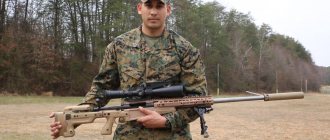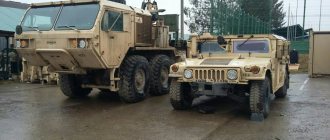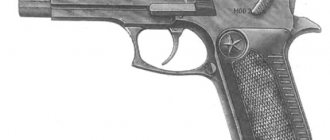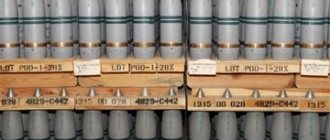Following the collapse of the Soviet Union, the two major nuclear powers remaining in the world, namely the United States and the Russian Federation, spent their early years in relative strategic nirvana. The leadership and people of both countries had a deceptive impression of the ensuing peace, guaranteed for many decades. The Americans considered their victory in the Cold War so convincing that they did not allow thoughts of further confrontation. The Russians did not feel like losers and expected an equal and benevolent attitude towards themselves as a people who voluntarily joined the Western democratic scale of values. Both were wrong. Very soon, a civil war began in the Balkans, in the outcome of which American weapons played a decisive role.
View gallery
The US leadership considered its success in dismembering the SFRY a good omen. It went further, striving to establish complete hegemony, allowing it to control material resources on a planetary scale, and suddenly at the beginning of the third millennium it came across resistance from Russia, a country that has the will and means to protect its geopolitical interests. The United States was not ready for this confrontation.
Before and during the war
Even on the eve of World War II, the United States was a peaceful country. The American army was not numerous, and its technical equipment remained quite modest. In 1940, a certain congressman boasted that he had seen all the armored vehicles of his country’s armed forces: “All 400 tanks!” - he declared proudly. But even then, certain types of weapons were given priority, and serious achievements by American designers were observed in the field of aircraft construction. America entered the war with a powerful air fleet, which included an armada of B-17 strategic bombers, Mustang and Thunderbolt long-range fighters, and other examples of excellent aircraft. By 1944, the United States began using the latest B-29s in the Pacific Ocean, beyond the reach of Japanese air defense systems. The US fleet was also impressive, powerful, aircraft-carrying and capable of crushing objects remote from the coast.
View gallery
American weapons of World War II were supplied to the USSR under the Lend-Lease program, and this concept included dual-use equipment. The beautiful Studebaker trucks, Willys and Dodge Three-Quarter jeeps enjoyed the well-deserved respect of Red Army drivers, and are remembered with kind words to this day. American military weapons, that is, those that are means of directly destroying the enemy, were assessed less clearly. The Airacobra fighter, on which the famous ace I. Kozhedub fought, had truly titanic firepower, excellent maneuverability and unprecedented ergonomics, which, combined with a strong engine, contributed to the achievement of many aerial victories. The transport Douglas was also considered a masterpiece of engineering.
Tanks made in the USA were rated quite low; they were outdated both technologically and morally.
America's military power rests on its ability to project power over long distances—that is, to deliver overwhelming force in the form of troops, ships, aircraft, and missiles to any corner of the world in a short period of time. While our closest competitors, Russia and China, do not have this “expeditionary” power projection, hypersonic weapons give their militaries a powerful anti-access or area denial (A2AD) tool, allowing them to deter US force deployments and even threaten a “decapitating” first strike. It's no surprise that Russia and China—and even second-tier competitors like Iran and North Korea—are actively pursuing this equalizing technology.
Hypersonic weapons have long since left the drawing board and are already being used by our adversaries. The Chinese People's Liberation Army (PLA) showcased the DF-ZF medium-range hypersonic glide vehicle (HGV) mounted on a standard DF-17 medium-range ballistic missile at the 2020 military parade. Although the system is officially armed with a conventional warhead and is designed to destroy stationary targets, experts believe that it could easily be equipped with nuclear warheads. In addition, it is reported that anti-ship “aircraft carrier killers” DF-ZF are also in development. With a range of 2,500 km and a maximum speed of Mach 10 - combined with extreme maneuverability in flight - the DF-ZF is designed specifically to defeat US missile defenses, including the Aegis missile defense that protects our ships, or the THAAD that protects ally South Korea.
The DF-ZF hypersonic glide vehicle demonstrated a high degree of accuracy in testing, with warheads landing "within meters" of the target, experts said. More importantly, the DF-ZF prototype is capable of evading an attack in flight, leaving the enemy “little time to react.”
Chinese officials are not shy about their achievements in this area - on the contrary, they have turned hypersonic weapons into a source of national pride. At the 2020 hypersonics conference in Xiamen, Chinese scientists presented more than 250 papers on the topic—almost ten times more than the Americans. It is known that in the decade between 2008 and 2020, China conducted approximately twenty times more hypersonic weapons tests than the United States.
Keeping up with its southern neighbor, Russia is developing its own hypersonic arsenal. On December 27, 2020, Russian Defense Minister Sergei Shoigu confirmed the deployment of the country's first hypersonic intercontinental ballistic missile (ICBM), the Avangard, calling it a "landmark event." Russian leaders have high hopes for it, and Russian President Vladimir Putin has boasted that Avangard is capable of bypassing both existing and future missile defense systems. This optimism is quite appropriate, and in tests in December 2020, the missile successfully hit a target at a distance of about 6 thousand km, moving along a “zigzag” trajectory at a speed of Mach 27.
Technologically, Avangard is apparently more advanced than its Chinese counterpart. Launched by the RS-28 Sarmat ICBM, the Avangard detaches high above the atmosphere and then “glides” towards the target. Additionally, Russia is close to deploying the Kinzhal hypersonic air-launched ballistic missile, which will reportedly reach speeds of up to Mach 10.
Spurred by the progress of its competitors, the United States is reviving its own Cold War-era hypersonic weapons program. The Pentagon has asked Congress for $2 billion 865 million to fund hypersonic weapons in 2021—a 13% increase over the fiscal year 2020 total ($2 billion 508 million). The request includes funding for research into offensive weapons systems - including a truck-mounted hypersonic system, missiles for submarines and surface ships, and air-launched weapons.
Requires mastery of the environment
The development of hypersonic defense is much more modestly funded - at least for now. Thus, the development of the Hypersonic and Ballistic Tracking Space Sensor (HBTSS), a joint project of the US Missile Defense Agency and the ACR, currently uses only a small part of the budgets of these agencies for “space technology development and prototyping.”
Zhongguo Junwan March 24, 2020 People's Daily March 16, 2020 The New York Times December 30, 2019
However, given the ability of hypersonic systems to detect holes in defenses - passing under radar horizons and staying out of range of interceptors until there is time to react - even an interception attempt requires a new tracking method. In fact, this can only be achieved through a constellation of sensors in low Earth orbit, as envisioned by the HBTSS program. This sensor constellation will include about 120 satellites, which will make it possible to constantly and reliably detect targets regardless of their course or speed. Such a system will “guard” any target from the moment of launch and provide interceptors with the necessary data in real time, when every millisecond counts.
The problem is urgent. Traditional U.S. defense systems—such as the ground-based mid-flight missile defense system, Aegis BMD, and THAAD—are simply not currently equipped to handle the hypersonic threat. Traditional missile defense—essentially shooting a bullet at another bullet—is itself a complex task and requires target tracking, high-speed data transmission and interception. The speed and maneuverability of hypersonic missiles make this task much more difficult. A layer of [sensors] placed in space will improve situational awareness and give existing systems a fighting chance against the threat. Moreover, the benefits of a space sensor layer will not be limited to missile defense. Each and every branch of the U.S. military will benefit from the ability to better track the security of combat units (from ships to troops to aircraft) in a common, integrated system.
The ability to launch such a system lies in the hands of Congress. With proper funding for research and development, lawmakers can ensure that the United States makes space sensing a reality—and ahead of its opponents.
James Grant is an associate fellow at the American Foreign Policy Council in Washington.
InoSMI materials contain assessments exclusively of foreign media and do not reflect the position of the InoSMI editorial staff.
Korea and the 50s
The American weapons of the ground forces of the post-war decade were practically no different from those with which the US Army fought against fascist Germany and militaristic Japan. Practically, these were the same Shermans, Willies, Studebakers, that is, either outdated models of armored vehicles, or excellent transport equipment created by the Detroit auto industry. Aviation is another matter. By joining the race of aircraft, General Dynamics, Boeing achieved a lot, taking advantage of the technological superiority achieved in those years when the fire of war raged in Europe (and not only). The largest strategic bomb carrier in history, the B-36, was adopted into service by the US Air Force, not without irony called the “Peacemaker.” The Saber jet interceptor was also good.
View gallery
The USSR soon overcame the gap in the field of fighter aircraft; Soviet tanks remained unquestionably the best in the world for decades, but in many other areas American weapons were superior to Soviet ones. This was especially true for naval forces, which had large tonnage and devastating firepower. And the main factor became nuclear warheads.
conclusions
It's strange to hear that the M16 rifle is better than the AK. Why? Let me explain.
M16 and AK are military weapons, the main purpose of which is to use them in real combat conditions. Yes, the M16 shoots more accurately and has less recoil, but its main drawback is NOT reliability in extreme conditions. That is, the M16 can fail in combat, dust, dirt, sand, and rain. Did I explain?
The beginning of the atomic race
The arms race truly began after the appearance in the arsenals of the United States and the USSR of a large number of atomic charges and means of delivering them to the target. After the vulnerability of piston-powered strategic bombers was convincingly proven in Korean skies, the parties focused their efforts on other methods of delivering nuclear strikes, as well as technologies for parrying them. In a sense, this deadly ping-pong continues to this day. At the dawn of the arms race, even such joyful events in the history of mankind as the launch of Sputnik and the flight of Gagarin, in the eyes of military analysts acquired an apocalyptic overtones. It was clear to everyone that in the event of a major war, American weapons, even the most modern ones, would not be able to play the role of a deterrent. At that time there was simply nothing to repel the attack of Soviet missiles; all that remained was deterrence provided by the guarantee of a retaliatory strike. And the number of warheads was constantly growing, and tests were constantly taking place, now in Nevada, now on Spitsbergen, now near Semipalatinsk, now on the Bikini Atoll. It seemed that the world had gone crazy and was moving with vigorous steps towards its inevitable death. Thermonuclear (or hydrogen) bombs appeared already in 1952, less than a year later the USSR already presented its answer.
Local wars
Another illusion that arose at the dawn of the Cold War was that the fear of a nuclear apocalypse would make local wars impossible. In a sense, this was true. American nuclear weapons aimed at large industrial and military areas of the USSR had the same sobering effect on the Soviet leadership as the missiles stationed in Cuba did on J. Kennedy. An open military conflict between the two superpowers never occurred. But the horror of the inevitable end did not prevent humanity from fighting almost continuously. The best American weapons were supplied to the pro-Western allies of the United States, and the USSR almost always responded to these actions by “providing fraternal assistance” to one or another freedom-loving people fighting against imperialism. It should be noted that the practice of such (often gratuitous) supplies to friendly regimes was stopped even before the collapse of the Union due to economic problems that arose. However, while the allies of the USSR and the USA were fighting among themselves, analysts had no doubt about the relative parity of the superpowers' weapons systems. In some cases, the domestic defense industry has demonstrated superiority over the overseas one. American small arms were inferior in reliability to Soviet ones.
Why doesn't the US attack Russia?
Unlike the Soviet and Russian defense industries, which have always been predominantly owned by the state, American arms firms are privately owned. Military budgets (or rather, their ratio) indicate that the US armed forces should be the most powerful in the world. The history of recent decades leads to the conclusion that their use is inevitable against an obviously weak enemy in the event of dissatisfaction with the American administration with the policies of a particular state declared a rogue state. The budget of the US Armed Forces in 2014 amounted to an astronomical amount of 581 billion dollars. The Russian figure is many times more modest (approximately 70 billion). It seems that conflict is inevitable. But it is not there, and it is not in sight, despite serious tensions with the superpowers. The question arises as to how much better the American army's weapons are than the Russian ones. And in general - is it better?
View gallery
Judging by all the signs, the United States currently does not have superiority (at least overwhelming), despite the gigantic amounts of military appropriations. And there is an explanation for this. It consists of the main goals and objectives of the American military-industrial complex.
American slot machines
The history of slot machines undoubtedly began in the United States of America, because it was there that the first “one-armed bandits” appeared, which became the prototype of modern online slots. American slot machines have become classics of gambling in offline casinos and a symbol of excitement around the world. Speaking of “one-armed bandits,” we immediately imagine this device with a screen on which reels and symbols for combinations are placed, a compartment for coins and a lever, by pulling which, each player hopes with bated breath for good luck. Among the many well-known slot machines, we have chosen those that are truly known in every casino and every player who tries these games.
Red, White and Blue is a slot machine that was not only one of the first, but also went through its own evolution. Created by IGT, it originally had 3 reels and seven symbols in three colors - red, white and blue - as well as stars and a Bar symbol, known as the bonus symbol in many slot machines. Today, Red, White and Blue is still popular in offline casinos, because in its appearance and origin it is truly American.
Top casino
Casino Vulcan 140,000 rub. for free!
Play
- Casino X 30 no deposit spins!
Play
- SuperSlots 140,000 rub. present
Play
- Gaminator 150 rub. no deposit!
Play
Wheel of Fortune was another brainchild of IGT, but developed by specialists from Anchor Games, the rights to which were later acquired by IGT. This American slot machine has a very exciting plot with classic symbols and since its inception has received several improved versions, each of which can still be found in American casinos.
Blazing Sevens from the Bally company appeared in the distant seventies of the last century, but still has not lost its relevance in the world of gambling and distributes winnings to all lucky ones. This is one of the few slot machines that offers a progressive jackpot, the amount of which starts at $1,000. This slot machine has its own secret to success and winnings.
Double Diamond appeared a little later than its predecessor, in 1989. And again, the developers from IGT did not stand aside. This slot machine perfected the doubling game that existed at that time: the diamond symbol automatically doubled the player’s winnings.
The Monopoly slot machine has become an even more exciting version of the famous board game Monopoly, which has gained immense popularity among players around the world. This slot machine already has 5 reels, which brings it as close as possible to the popular online slots that are thundering around the world today as the most successful and popular casino games.
How does the American military-industrial complex work?
It's all about private ownership. American arms manufacturers are interested in observing the fundamental law of capitalist society, for which His Majesty Profit is the main shrine. Technical solutions that require low material costs, even if ingenious, are usually rejected outright. New American weapons must be expensive, technologically rich, complex, and have an impressive appearance so that taxpayers can admire them and be convinced that their hard-earned money was not wasted.
View gallery
While there is no major war, it is difficult (if not impossible) to assess the effectiveness of these samples. And against a technically weak enemy (such as Iraq, Yugoslavia, Libya or Afghanistan), using the wonders of technology is generally a win-win. Apparently, the US Army is not going to fight a strong enemy. At the very least, it is not making technical preparations for an attack on China, India or Russia in the near future. But spending budget funds on promising secret American weapons is a win-win, but very profitable. The general public is promised hypersonic missiles and fantastic unmanned aircraft. The latter already exist, for example the Predator in strike and reconnaissance versions. True, it is unknown how effective they will be in the face of powerful air defense. Over Afghanistan and Libya they were relatively safe. The newest stealthy Raptor interceptors are also untested in combat, but they are so expensive that even the American budget cannot support them.
The main trend of recent decades
The already mentioned relaxation that came after the victory in the Cold War prompted a change in the structure of spending of the US military budget in favor of preparation for a series of local wars planned in order to achieve a new geopolitical picture beneficial for the US and NATO. The nuclear threat from Russia has been completely ignored since the early 90s. The weapons of the American army were created taking into account their use in precisely such conflicts, which are close in nature to police operations. Advantage was given to tactical means to the detriment of strategic ones. The United States still holds the world lead in the number of nuclear warheads, but most of them were manufactured a long time ago.
View gallery
Despite the fact that their service life has been extended (for example, the Minutemen - until 2030), even the most cheerful optimists are not confident in their ideal technical condition. The US plans to begin developing new missiles only in 2025. Meanwhile, the Russian state did not miss the opportunity to improve its nuclear shield. Against the background of the emerging lag, the American leadership is making attempts to create systems capable of intercepting ICBMs, and are trying to move them as close as possible to the borders of the Russian Federation.
Bushmaster ACR 3
The assault rifle of the American company Bushmaster Firearms International was first conceived as a modernization option for the M16 , but during the development process several new structural elements were introduced.
In particular, when replacing several parts, you can change the class of the weapon (meaning the cartridge used and the length of the barrel); thanks to the roughness of the body, the weapon practically does not slip in the hands. Aluminum alloys and polymers are widely used in the production of the machine. The firing mode controls and the shutter stop button are located on two sides of the body, and the charging handle can be easily moved from one side to the other. The sighting range is 500 m, the cartridges used are 5.56x45 and 7.62x39 mm. The weight of the machine gun is 3.18 kg, the magazine holds 30 rounds.
# # #
American missile defense systems
According to the plan of overseas strategists, the most likely enemy in a proposed global conflict should be surrounded on all sides by means of detecting and intercepting ICBMs, combined into a single complex. Ideally, Russia should also fall under a kind of “umbrella” woven from invisible satellite orbits and radar beams. New American weapons are already stationed at many bases in Alaska, Greenland, and the British Isles, and they are continuously being modernized. An extensive warning system for a possible nuclear missile strike is based on AN/TPY-2 radar stations located in Japan, Norway and Turkey, countries that have common borders or are closely adjacent to Russia. The Aegis early warning system was installed in Romania. According to the SBIRS program, 34 satellites are being launched into orbit according to plan.
View gallery
Space resources (both literally and figuratively) are spent on all these preparations, but their real effectiveness raises certain doubts due to the fact that Russian missiles can overcome the most modern missile defense systems - both existing and being created, and even planned.
View gallery
"Trunks" for export
American advanced weapons account for approximately 29% of global defense exports. Russia is coming “on the heels” of the United States with its 27 percent. The reason for the success of domestic manufacturers lies in the simplicity, efficiency, reliability and relative cheapness of the products they offer. In order to promote their goods, Americans have to act in different ways, including using political influence on the governments of importing countries.
View gallery
Sometimes simplified and cheaper designs are developed for the foreign market. American small arms, which in most cases are modifications of time-tested and combat experience-tested models that have been in service since the Vietnam War (M-16, M-18 rapid-fire carbines), enjoy well-deserved success in many countries. The newest “barrels” are considered to be the P-226 pistol developed in the 80s, the Mark 16 and 17 assault rifle and other successful designs, but in terms of popularity they are far from the Kalashnikov due, again, to their high cost and complexity.
History of the M16 rifle
Just as everyone knows the Kalashnikov assault rifle, everyone knows the American M16 rifle. She is undisputedly the No. 2 weapon in the world. Although Americans (not all) will argue with me.
Research in 1948 took place with the goal of creating an improved weapon model.
Start
The history of the M16 rifle began in 1948. The Americans conducted research to create an improved weapon model.
Arma Lite's chief engineer, Eugene M. Stoner (1922–1997), worked on his first assault rifle, which was designated the AR10 (Model 10 Arma Lite Rifle), in the early 1950s.
Read on topic: Simonov automatic rifle, ABC-36
The AR10 was the first weapon to use GeneStoner's patented (US Patent No. 2,951,424) system for removing spent propellant gases from the bore through a gas outlet tube. In fact, the patent concerned aviation and Stoner successfully used its principle for the AR10.
In '57, General Wyman, impressed by the merits and results of the AR10, went to Arma Lite. There he asked Gene Stoner to continue the work, in return offering financial support to Arma Lite for the future development of Arma Lite rifles. In exchange, ownership rights to the final product were offered.
Work continued and Arma Lite subsequently introduced a completely new concept for modern weapons, the 22-caliber battle rifle. As a result, the 30-caliber AR10 ended its service in the US Armed Forces.
First tests of the AR15 rifle
The first tests of the AR15 M rifle (Arma Lite Rifle model 15) in 1958 were successful. In 59, the rights to develop the design were obtained by a fairly well-known company, Colt's Patent Firearms Manufacturing. Designer Gene Stoner begins work in this company.
Original AR15; gun configuration that Colt purchased from ArmaLite.
On 02/19/59, Colt of Hartford, CT purchased the rights to the AR15 and AR10 FairchildStratos (Arma Lite) for $75K plus a 4.5% interest on all future AR15/10 production.
Read on topic: Simonov automatic rifle, ABC-36
Colt also paid Cooper and McDonald (a group that operated in Southeast Asia) $250,000 and a one percent royalty on all production of the AR15 and AR10 rifles.
American M16 rifle: appearance of the model
After extensive testing of the AR15 rifle, as well as the purchase by the army of 100 thousand barrels in 64, significant shortcomings of the AR15 were identified, which they tried to correct in the next model, the M16 rifle. The leadership of the military forces adopted the M16 model in 1964.
In September '65, General Westmoreland ordered an additional 100,000 barrels and demanded that all US ground forces in Vietnam be equipped with the new M16A1 rifles.
Colt now signed an additional contract for the delivery of 25 thousand barrels per month by December 66. In '68, GMHydramaticDivision and HarringtonRichardson received contracts from the Department of Defense.
In 1967, the American M16 rifle appeared under the name “US Rifle, 5.56mm, M16A1.”
The differences between the M16 and the M16A1 are very obvious when the rifles are compared side by side. M16 (top) and M16A1 (bottom).
The Vietnam War did not show the best side of the M16. She needed special service conditions and often malfunctioned.
“Letters from the battlefield began to report that American troops were finding dead soldiers next to misfired M16 rifles.”
Read on topic: Simonov automatic rifle, ABC-36
1981 was marked by the appearance of an improved model, and a year later the rifle received the designation “US Rifle, 5.56mm, M16A2”
The next model M16A3 (5.56×45mm NATO) appeared in the army in 1994.
"Javelin" - American anti-tank weapon
The use of guerrilla warfare, the complex nature of the modern theater of war, and the advent of compact man-portable weapons have revolutionized the science of tactics. The fight against armored vehicles has become one of the most important tasks. Due to the expansion of the geography of local conflicts in the world, the demand for American anti-tank weapons is possible. The reason for the shift in import channels is not primarily the superiority of overseas samples over Russian ones, it lies in political motives. The Javelin anti-tank missile system has recently become most famous in connection with negotiations on possible deliveries from the United States to Ukraine. The new complex costs $2 million and includes a sighting and launch system and ten rockets. The Ukrainian side agrees to purchase used units, but at a price of $500 thousand. How the negotiations will end and whether the deal will take place is still unknown.
AK-12
This assault rifle continues the world-famous line of Kalashnikov assault rifle models, the reliability and technical characteristics of which are legendary.
The AK-12 was developed in 2011 and entered into service in 2020. This model allows you to perform all operations with a machine gun with one hand; the reloading handle can be easily reinstalled on the side desired by the fighter. The telescopic adjustable stock folds in 2 directions and can be easily removed if necessary.
A wide range of modules can be installed on the machine - grenade launchers, flashlights and sights. The weapon is produced under both domestic and NATO standard cartridges. The rate of fire of the AK-12 is 650 rounds/min. at a target range of up to a kilometer. Ammunition is supplied from a box magazine with 30, 60 or disk magazines with 95 rounds, the weight of the machine gun excluding the magazine is 3.2 kg.








